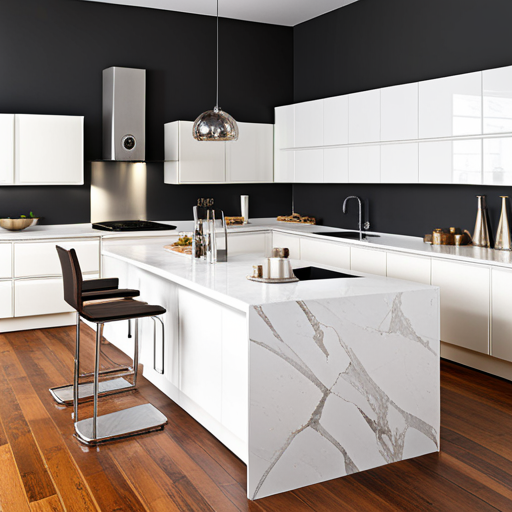How To Remove Kitchen Worktops

In the realm of home improvement and renovation, few projects hold as much transformative power as updating your kitchen. Whether you’re looking to revamp your cooking space entirely or simply aiming to replace a worn-out worktop, the process of removing this essential kitchen fixture can feel daunting. However, with the right knowledge and a systematic approach, removing worktops can become a manageable task that paves the way for exciting new possibilities.
This guide aims to equip you with the necessary insights and step-by-step instructions to confidently navigate the process of worktop removal. From identifying common types of worktops to understanding essential tools and techniques, let’s explore ways through which you can effectively remove kitchen worktops.
Request Quote

Materials Needed to Remove a Kitchen Worktop
Removing a kitchen worktop requires a few essential tools and materials to ensure a smooth and efficient process. Here are the materials you’ll need:
1. Safety Equipment
– Safety goggles: Protect your eyes from debris, dust, and potential hazards.
– Work gloves: Provide hand protection while handling sharp or heavy objects.
– Dust mask or respirator: Prevent inhalation of dust and particles generated during the removal process.
2. Basic Hand Tools
– Screwdriver: Used to remove screws, brackets, or other fasteners securing the worktop.
– Pry bar or crowbar: Helps in prying the worktop away from the cabinets or supports.
– Hammer: Assists in removing nails, tapping the worktop to loosen it, or disassembling fixtures.
3. Power Tools
– Drill/driver: Used to unscrew any screws or fixings securing the worktop to the cabinets or supports.
– Jigsaw or reciprocating saw: Helpful for cutting through sealants, adhesive, or any sections of the worktop that need to be modified or removed.
– Oscillating multi-tool: Useful for cutting or scraping in tight or hard-to-reach areas, such as backsplash or corners.
4. Protection for Surfaces
– Drop cloths or plastic sheets: Place them on the floor and surrounding surfaces to protect against debris, scratches, or accidental spills.
– Painter’s tape: Use it to secure the drop cloths or plastic sheets in place and protect walls or adjacent surfaces from damage.
5. Lubricants and Solvents
– Lubricant spray: Helps loosen stubborn screws, bolts, or hinges that may be holding the worktop in place.
– Adhesive solvent: If the worktop is secured with adhesive or sealant, a solvent can aid in softening and loosening the bond for easier removal.
6. Utility Knife
A sharp utility knife will come in handy for cutting through any sealant or adhesive along the edges of the worktop.
7. Protective Covers or Bags
Use these to cover and protect cabinets, appliances, or other items in the vicinity of the worktop during the removal process.
Having these tools and materials readily available will make the task of removing a kitchen worktop more efficient and safer. Remember to follow proper safety precautions and use the appropriate tools for each step to ensure a successful removal without causing damage to the surrounding area or yourself.

Steps Involved in Removing a Kitchen Worktop
1. Gather Your Tools
First, make sure you have all the tools necessary for this task. These may include screwdriver, putty knife, pry bar, hammer, utility knife, pluber’s wrench, etc.
2. Switch off Water and Gas Supplies:
Before you begin, make sure all water and gas supplies are shut off. This should include the sink’s water supply and any gas knobs on the cooktop (if applicable).
3. Disconnect the Sink
Remove all attachments and plumbing from the sink, such as the drain, water supply, and garbage disposal (if fitted). Once everything is disconnected, lift the sink out from its place.
4. Disconnect Appliances
Next, you’ll need to disconnect any appliances connected to your worktop. These could include your stove, dishwasher or any other integrated appliances.
5. Remove the Screws
Find and unscrew all the brackets holding your worktop in place. Use a screwdriver to remove any screws connecting the countertop to the cabinets.
6. Begin Removal of the Worktop
Use a utility knife to cut through any caulk or adhesive joining your counter to the wall or to the cabinets below. Following this, place a putty knife between the wall and the kitchen countertop and gently pry it away from the wall. Repeat this action along the length of the wall until the countertop is no longer attached to the wall.
7. Lift off the Worktop
With a helper if needed, lift the counter straight up and off the cabinets. If the countertop is too large or heavy, you may need to cut it into smaller, more manageable sections with a circular saw.
8. Inspect After Removal
After you have removed the countertop, inspect your cabinets and walls for any damage. If there are any tears or scratches on your wall, repair them before installing a new countertop.
9. Dispose of the Old Countertop
Lastly, ensure that you dispose of your old countertop responsibly. You may also choose to recycle or donate your countertop if it’s in good condition.
In conclusion, removing a kitchen countertop doesn’t have to be expensive or complicated. With the right set of tools, safety measures, and a little bit of effort, you can complete this task satisfactorily. Ensure that you thoroughly clean up after the removal process to ensure your space is ready for the next home improvement project—whether that’s refinishing the cabinets or installing a brand new kitchen worktop.

Advantages of Removing a Kitchen Worktop
Removing a kitchen worktop can bring about several advantages, both functional and aesthetic. Let’s explore some of the key benefits of removing a kitchen worktop:
Enhanced Design Flexibility
By removing an old or outdated worktop, you open up a world of design possibilities. This allows you to reimagine and transform your kitchen space according to your personal style and preferences. Whether you opt for a modern, minimalist look or a rustic, farmhouse vibe, removing the existing worktop provides a blank canvas to create a fresh and inviting kitchen aesthetic.
Improved Functionality
Worktop removal offers an opportunity to reassess and optimize the functionality of your kitchen.
You can reconfigure the layout, adjust the height or depth of the worktop, or even introduce additional work surfaces to improve workflow and efficiency. Removing a worktop gives you the freedom to customize your kitchen according to your specific needs, ensuring a more practical and user-friendly space.
Upgraded Materials and Durability
If your current worktop is worn, damaged, or made from subpar materials, removing it allows you to upgrade to a more durable and resilient surface. Upgrading to high-quality materials, such as quartz, granite, or solid wood, can enhance the longevity and performance of your kitchen worktop, reducing the need for frequent repairs or replacements in the future.
Increased Home Value
A well-designed and functional kitchen can significantly impact the value of your home. By removing an outdated or poorly maintained worktop, you can revitalize the kitchen’s appearance and create a more appealing space for potential buyers. Upgrading to a stylish and durable worktop can be a key selling point, attracting prospective homeowners and potentially increasing the resale value of your property.
Health and Hygiene
Over time, worktops can accumulate bacteria, stains, and other contaminants that are difficult to remove completely. Removing an old worktop and installing a new one ensures a fresh start, promoting a cleaner and more hygienic cooking environment. Non-porous materials like quartz or stainless steel can help inhibit the growth of bacteria and facilitate easier cleaning, reducing the risk of cross-contamination and promoting a healthier kitchen atmosphere.
Frequently Asked Questions
1. Can you remove a countertop without breaking it?
In many cases, it is possible to remove a countertop without breaking it. However, it requires careful planning, preparation, and execution to minimize the risk of damage. The key is to follow the appropriate removal method for the specific countertop material.
2. Is it easy to remove countertops?
The difficulty of removing countertops varies depending on the material and the method of installation. Some countertops, such as laminate or tile, can be relatively easier to remove compared to solid surfaces like quartz or granite. The complexity of the removal process also depends on factors like the size of the countertop, the presence of seams or joints, and the level of adhesion to the base cabinets.
3. Can you unglue granite countertops?
Yes, it is possible to unglue granite countertops, but it requires specific techniques and tools. Professional help is often recommended to ensure the safe removal of the granite without causing damage.
4. What glue remover is suitable for granite?
When it comes to removing adhesive or glue from granite, it’s important to use a product that is safe for stone surfaces. Acetone or a specialized adhesive remover formulated for granite can be used. However, it is best to consult with a professional or the manufacturer of the granite to determine the most suitable product for your specific situation.
5. Does salt and water remove glue from granite?
Salt and water are unlikely to effectively remove glue from granite. The adhesive used for granite countertops is typically strong and requires a specialized remover or solvent for effective removal.
6. Does soapy water remove glue from granite?
Soapy water alone is unlikely to remove glue from granite. While it may help with cleaning the surface, a dedicated adhesive remover or solvent is necessary to dissolve and remove the glue effectively.
References
- https://www.caesarstoneus.com/blog/what-to-do-about-stains-on-quartz-countertop
- https://www.msisurfaces.com/blogs/post/2021/05/19/how-to-get-marks-stains-and-water-spots-off-of-quartz-countertops.aspx
- https://guilincabinets.com/quartz-countertop-clean-maintain-remove-stains
Visit Us
Wakefield, United Kingdom
Message Us
hello@kitchenworktopswakefield.co.uk
Get an Online Quote
Get Started
